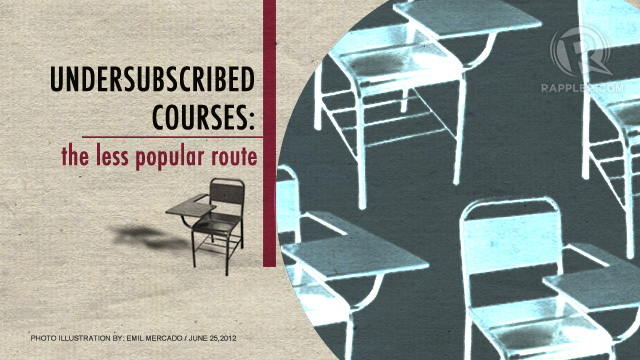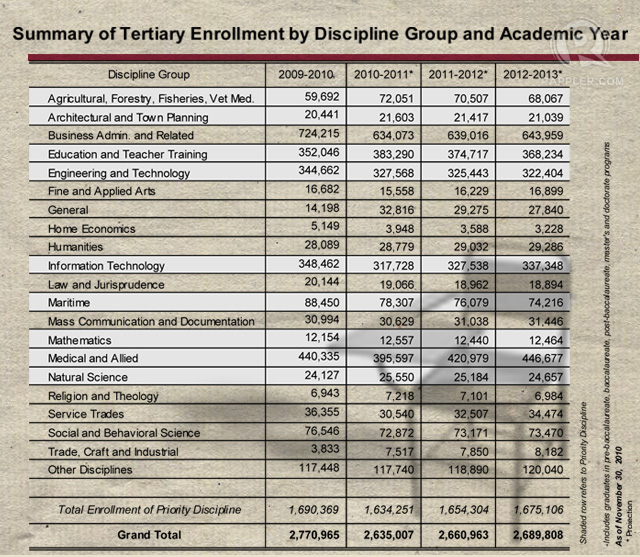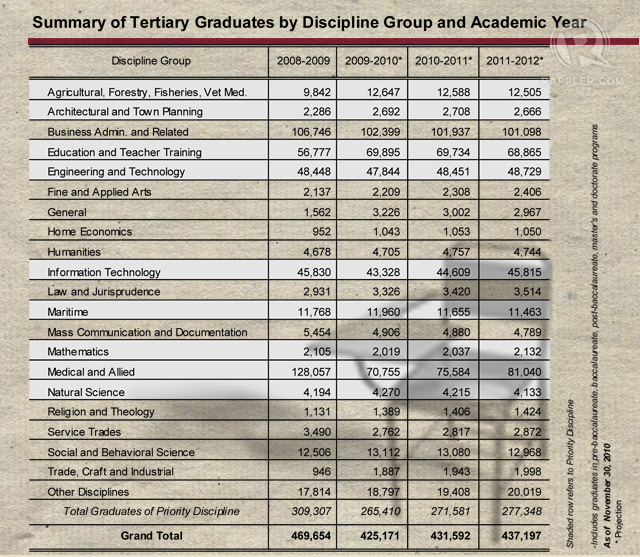SUMMARY
This is AI generated summarization, which may have errors. For context, always refer to the full article.

MANILA, Philippines – Since it was established in 1992, the BS Environmental Science course at the Ateneo de Manila University has rarely exceeded 20 freshmen.
“Enrollment was fairly constant between 10-15 freshmen each school year,” said Dr Emilyn Espiritu, chairperson of the Department of Environmental Science. This figure pales in comparison with other courses in the university, which enroll dozens, even hundreds, of students.
This is most evident during the annual OrSem, the university’s freshman orientation seminar: programs such as management and communication are represented by several blocks, whereas ES freshmen barely form a block, much less fill a row of seats. (A block normally has 25-30 students).
Environmental science is just one of dozens of “undersubscribed” courses, or those college programs that have low enrollment and graduation rates, as opposed to “oversubscribed” courses such as nursing, business administration, and teacher education.
Many of these programs are in the field of science, technology, and engineering – courses such as physics, chemistry, geology, and mining – as well as those in agriculture and fisheries.
“This is a generally problematic situation in almost all universities in the country,” Espiritu said.
Impact on jobs
Julito Vitriolo, executive director of the Commission on Higher Education (CHED), said this has impact on the labor force. “Because of the dearth of graduates in certain fields, certain industries can have a hard time getting enough manpower,” he said.
With only a few graduates trained in these specialized courses, Vitriolo said there are many hard-to-fill jobs.
“For example, in mining, it’s an engineering course, technology-based. But there are only a few students who enroll in the course. Add to that only around two schools offer the program [in Metro Manila],” he added.
“In our case, if our manpower is depleted (in a certain field), it will affect our competitiveness,” he said, citing eventual problems in the country’s research base and scientific development.
Even non-science courses are also affected by low enrollment and graduation figures, making them undersubscribed, according to Vitriolo.
How does one identify an “undersubscribed” course? Vitriolo said there is no strict definition, but the commission uses numerous indicators to distinguish these.
One indicator is the number of schools offering a certain program. About 35 schools are offering environmental science degree programs, based on CHED monitoring data; out of these, only 10 offer graduate programs.
On the other end of the spectrum, nursing, one of the 5 “oversubscribed” programs identified by the CHED, is being offered by at least 490 schools nationwide.
Other indicators include low enrollment and graduation rates compared to other programs, with some courses even failing to form at least one block or class.
Consistently low
Data from CHED for school years 2001-2002 to 2012-2013 showed that courses on discplines such as Agriculture, Architectural and Town Planning, Natural Science, and Mathematics have consistently low enrollment figures, all consistently below 100,000 annually.
The discipline group with the lowest enrollment figures during the past decade has been the Trade, Craft and Industrial disciplines, and Home Economics.
Meanwhile, discipline areas such as Education and Teacher Training, and Medical and Allied Professions have six-figure enrollment rates. Business Administration and Related courses have the highest enrollment figues in the time period: its “worst” figure was 516,937 students for SY 2004-2005. It peaked at more than 724,000 students in SY 2009-2010.

Graduation rates more or less mirror the enrollment figures.

Undersubscribed programs also vary by region or area, he explained. “It is possible that in Metro Manila, a course is oversubscribed, while it is not popular in other regions,” he said.
Moratorium
In 2010, CHED chairperson Patricia Licuanan released CHEd Memorandum Order Number 32, which placed a moratorium on establishing new programs on 5 “oversubscribed” courses starting school year 2011-2012
The memorandum stopped the creation of new undergraduate and graduate programs in the 5 major oversubscribed courses: business administration, nursing, teacher education, hotel and restaurant management, and information technology.
These programs have been producing very large number of graduates, but the labor force can only absorb so much of them.
It was part of the commission’s move to promote and grow the other courses, Vitriolo said, by encouraging students to enroll in undersubscribed programs.
The moratorium still holds, he said, and the commission is evaluating if it is still needed.
The CHED moratorium is by far the most evident push to entice students to take the less popular route and enroll in less “famous” degree programs. Government agencies and schools also try to entice enrollees by offering scholarships and special programs.
The commission has also designated Priority Disciplines, or fields of study that will be the focus for growth in the next few years, and are seen as vital in the country’s development.
These are:
- Agriculture, Forestry, Fisheries, and Veterinary Medicine
- Architectural and Town Planning
- Education and Teacher Training
- Engineering and Technology
- Information Technology
- Maritime
- Mathematics
- Medical and Allied Professions
- Natural Sciences
Except for Education and Teacher Training and Information Technology, most of these Priority Disciplines are also undersubscribed programs, and are seen to benefit from the additional push.
Challenge to schools
Academic institutions should also do their part in promoting these programs, Vitriolo said.
Colleges and universities should not focus too much on the “popular” programs, and should balance out their course offerings to also give way to the “unpopular” ones, he said.
The educational institutions should also increase their advocacy of these programs, to heighten their importance in the current labor force and in society in general.
In the case of Ateneo’s ES program, the increasing awareness about environmental issues is also rubbing off on students’ awareness of the program, Espiritu said.
“Before, it was difficult for people to imagine what kinds of careers they will have if they pursued a degree in environment, the options and possibilities became clearer as more and more awareness about the environment happened among the population,” she said.
Last year, the program had 35 freshmen, finally being able to form one block of students. This year, the number is slightly down (25), but nonetheless higher than the average number of students in the previous years.
“We are seeing a steady and increasing interest in environment as a career of choice,” she said.
Matching graduates and jobs
Even the Department of Labor and Employment (DOLE) is echoing the call of the CHED for students to move toward undersubscribed programs.
At the start of the new school year, the labor department emphasized the need for career guidance. In particular, they encouraged high school students to study and analyze labor market information to see which courses will be in demand in the future.
“Instead of taking popular courses, those less considered courses may prove to be the best paying and the most productive ones. They may even venture into part-time careers and entrepreneurship opportunities that are usually overlooked,” Labor Secretary Rosalinda Baldoz recently said.
This could also help address shortages and mismatch in certain labor sectors, such as agriculture, mining, construction, and services.
Vitriolo said that students should not just choose their college courses “because they are popular.”
“They also have to explore other avenues… try other areas,” he said, and students just might discover their other skills and talents that will eventually be helpful to their personal as well as the nation’s development.
“I hope they choose their courses well,” he said. – Rappler.com
Add a comment
How does this make you feel?
There are no comments yet. Add your comment to start the conversation.